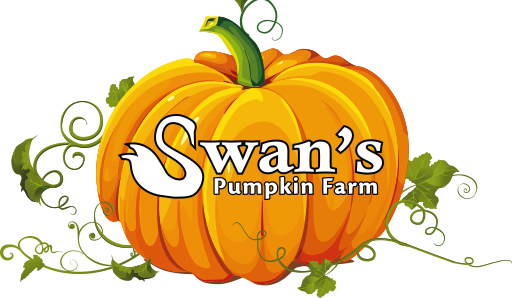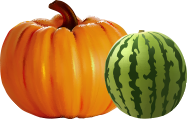Swan's Pumpkin Farm Frequently Asked Questions
Do you have wagons that people can use while visiting your farm?
We have wheelbarrows available to carry purchases. The are available near the main entrance and we ask to hold your driver's license until you return the wheelbarrow.
Do you sell seeds?
We do not sell pumpkin seeds for planting in your garden.
Why are pumpkins different sizes and shapes?
Pumpkins grow in many different shapes for a variety of reasons. Weather is one factor, since pumpkins were originally grown in northern climates those are the ones we recognize as "traditional." As pumpkins moved with the settlers to different climates throughout the United States, different species had to be developed depending on the climate. Humans have had the most impact as we save and plant seeds from only the heartiest, or the smallest, or the sweetest pumpkins, depending on what kind of pumpkin they were looking for.
Why do some pumpkins grow to be very large?
Many growers cross-pollinate different varieties of pumpkins to create new ones. All "Giant" pumpkins grown today evolved from seeds developed by William Warnock around the turn of the century. He grew the very first record-breaking pumpkin in 1893. It weighed 365 pounds.
How can I determine if the pumpkins my family grew are ripe?
Pumpkins should be harvested before the first hard frost, which kills the vines and ruins pumpkins for storage. When pumpkins are mature, their vines and leaves shrivel, turn brown and die back. Fruits turn from yellow to bright orange, and rinds harden.
How do I cook pumpkins?
Smaller, pie pumpkin varieties such as the New England Sugar or Baby Pam are good to use for cooking because they have a sweeter flavor. Choose a pumpkin that is heavy for its size (about 3-5 pounds), has a hard rind, and is free of blemishes or bruises. A 3½ lb. pumpkin yields approximately 1 cup of pumpkin puree. You can bake, boil, steam, or pressure-cook fresh pumpkin.
Microwave: On high, 7 minutes per pound.
Oven: Halved, cut-side down, 350 degree oven at least one hour.
Stove: In small amount of water, puncture and cook whole, or peel and cut into 1-inch cubes. Boil covered until tender.
To puree the cooked pumpkin, scoop out and process in a blender until thick and smooth. The cooked pumpkin may be refrigerated up to 3 days. Use this pumpkin as you would pumpkin from a can. To freeze the cooked pumpkin, pack in bags or plastic containers for up to several months.
Here's a great pumpkin pie recipe, courtesy of Vala's Pumpkin Patch in Gretna, Nebraska:
1½ c. canned or cooked pumpkin or squash
1 c. brown sugar, firmly packed
½ tsp. salt
2 tsp. cinnamon
1 tsp. ginger
2 T. molasses
3 eggs, slightly beaten
12 oz. can of evaporated milk
1 unbaked pie shell
Combine pumpkin, sugar, salt, spices and molasses. Add eggs and milk and mix thoroughly. Pour into unbaked ie shell and bake in hot oven (425°) for 40 to 45 minutes, or until knife
inserted comes out clean.
Am I able to cook the seeds?
Seeds can be roasted and eaten, or can be dried and given to the birds and squirrels. To roast pumpkin seeds, clean out the pumpkin, remove seeds from the pumpkin goo, and wash them thoroughly. Let them dry for a day or so on a paper towel. Put 1 tablespoon of oil in a bowl, add 2 cups of dried seeds and toss them until they are all coated with oil. Spread them out on a cookie sheet. Bake them in a 350-degree oven for about 45 minutes. Stir them every 10 or 15 minutes while they are baking. Shell and eat like sunflower seeds.
Does something happen to pumpkins once they've been frozen? Do they get mushy? Can someone still carve them?
Pumpkins frozen in the field will not last as long and will rot more quickly than pumpkins picked before freezing weather sets in. Depending on how solidly frozen they have become, they may be too soft to carve when thawed.
How do you preserve a Jack-o-lantern?
To keep a pumpkin from drying out, cover it with a damp towel when it is not on display. To make your pumpkin last longer, wait for half an hour after you finish carving, then rub the cut areas and inside with a dry cloth and apply a protective coating such as petroleum jelly, clear furniture wax, or vegetable oil painted on with a brush. Some expert pumpkin carvers use several coats of lacquer or hair spray, which gives it a nice glossy finish.
Are wholesale pumpkins and watermelons available?
Yes, Swan's Pumpkin Farm does provide our pumpkins and watermelons at wholesale upon request. Please contact Ken Swan for further details or to place an order.
 262-835-4885
262-835-4885 



Social